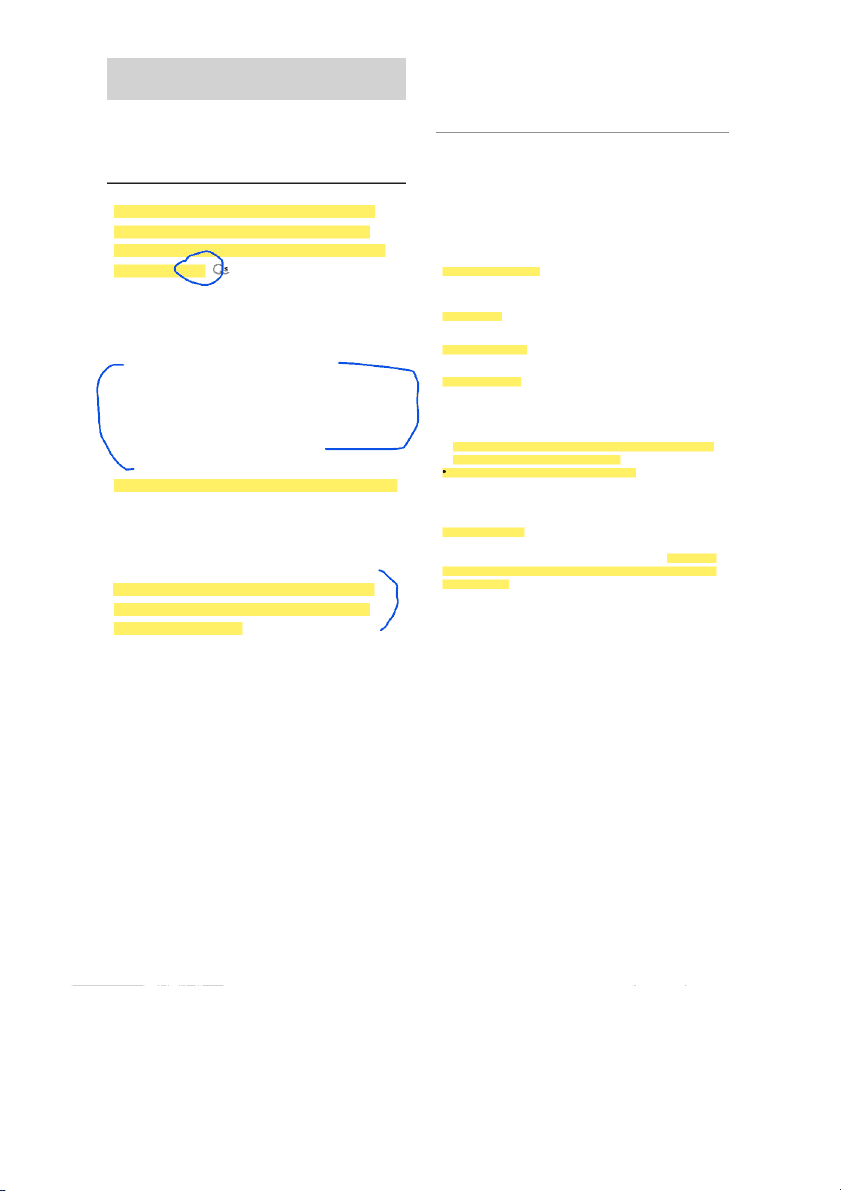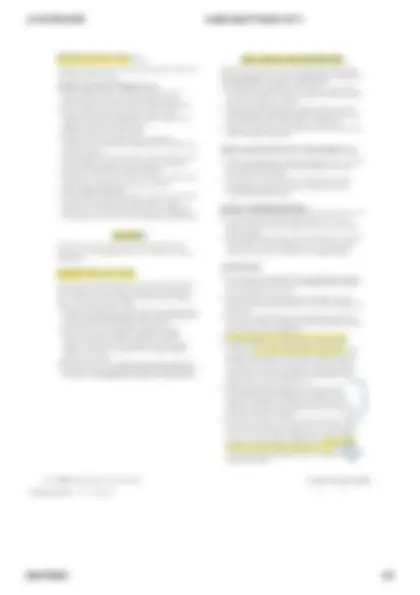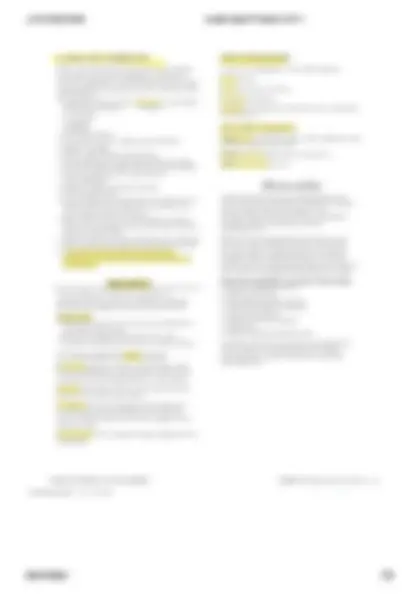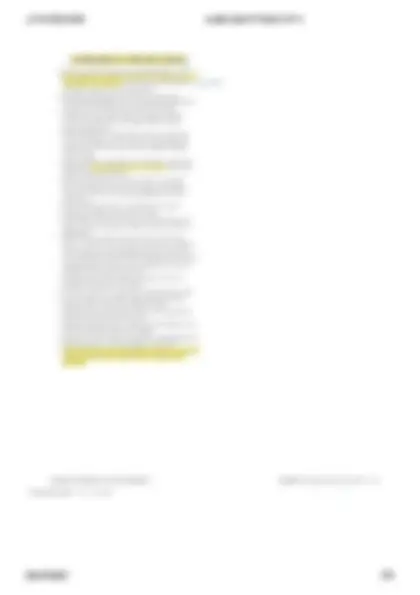







Study with the several resources on Docsity

Earn points by helping other students or get them with a premium plan


Prepare for your exams
Study with the several resources on Docsity

Earn points to download
Earn points by helping other students or get them with a premium plan
Community
Ask the community for help and clear up your study doubts
Discover the best universities in your country according to Docsity users
Free resources
Download our free guides on studying techniques, anxiety management strategies, and thesis advice from Docsity tutors
Leadership ATI Book CHP 4 Course: Leadership And Management In Healthcare (RN 400A) University: Unitek College
Typology: Study notes
1 / 9

This page cannot be seen from the preview
Don't miss anything!






● (^) A culture of safety is one that promotes openness and error reporting. Developing a culture of safety often ● results in a lower number of adverse events. Facilities should have a risk management department to help identify and prevent adverse events, hazards, track the occurrence of negative client incidents, and help ● manage the hazards. There are several types of events that are reported and tracked under risk management programs. Service occurrences relate to client services, and can include a slight delay in service or an unsatisfactory service. Near misses are situations where a negative outcome almost occurs (an accident, illness, or injury. Serious incidents reported include minor injuries, loss of equipment or property, or a significant service interrupted. Sentinel events refer to unexpected death or major injury, whether physical or psychological, or situations where there was a direct risk of either of these. Major investigation is required in the case of sentinel events. Sent ● inel events are classified as one of the following. Major loss of function or death that was not expected with the client’s medical condition Client attempted suicide during round-the-clock care, a hemolytic transfusion reaction, wrong site or wrong client surgical procedures, rape, infant abduction, or discharge to the wrong family. Failure to rescue is the most severe, and describes a situation where the client develops a complication that leads to death. In failure to rescue situations, there were client indicators that were missed by one or more health care personnel that indicated that a complication was occurring.
QSEN competencies in nursing programs Concern about the quality and safety of health care in the U.S. has prompted numerous reports and initiatives designed to address this issue. Data from the Joint Commission identify poor communication as a key factor in the majority of sentinel events. The Institute of Medicine (IOM) report To Err is Human: Building a Safer Health System ( 1999 ) spoke to the frequency of unnecessary deaths and preventable medical errors, and identified system failure as a major factor. Subsequent publications pointed to the need to redesign the provision of client care and improve education of students in health care programs. The QSEN project identified specific competencies to include in each prelicensure nursing curriculum. These six competencies are now integral components of the curriculum of many nursing programs in the U.S. PATIENT‑CENTERED CARE: The provision of caring and compassionate, culturally sensitive care that addresses clients’ physiological, psychological, sociological, spiritual, and cultural needs, preferences, and values TEAMWORK AND COLLABORATION: The delivery of client care in partnership with multidisciplinary members of the health care team to achieve continuity of care and positive client outcomes EVIDENCE‑BASED PRACTICE: The use of current knowledge from research and other credible sources on which to base clinical judgment and client care QUALITY IMPROVEMENT: Care-related and organizational processes that involve the development and implementation of a plan to improve health care services and better meet clients’ needs SAFETY: The minimization of risk factors that could cause injury or harm while promoting quality care and maintaining a secure environment for clients, self, and others INFORMATICS: The use of information technology as a communication and information-gathering tool that supports clinical decision-making and scientifically-based nursing practice Handling infectious and hazardous materials ● (^) Handling infectious and hazardous materials refers to infection control procedures and to precautions for handling toxic, radioactive, or other hazardous materials. Safety measures are taken to protect the client, nurse, and other personnel and individuals from harmful materials and organisms.
Infection control is extremely important to prevent cross-contamination of communicable organisms and hea ● lth care-associated infections. Staff education on infection prevention and control is a ● responsibility of the nurse. Facility policies and procedures should serve as a resource for proper implementation of infection ● prevention and control. Clients suspected of having or known to have a communicable disease should be placed in the ● appropriate form of isolation. The nurse should ensure that appropriate equipment is available and that isolation procedures are properly ● carried out by all health care team members. Use of standard precautions by all members of the health care team should be enforced. Employees who are allergic to latex should have non-latex gloves (nitrile or vinyl) made available to them. A latex-free environment is provided for clients who have a latex allergy. Many facilities avoid the use of latex products unless there is no other alternative. ● Facilities should provide resources for employees to perform hand hygiene in client care areas. ● Use moisture-resistant bags for disposing of soiled items, tied securely. To remain cost- effective, only double-bag if the outside of a bag becomes contaminated. ● (^) Use safety needles or needless IV systems to prevent care and staff injuries from improper manipulation. ● (^) Dispose of sharps in sharps containers immediately after use. ● (^) If a needlestick occurs, report it to facility risk management in accordance with facility policy and state law. An incident or occurrence report should also be filed. Most policies include testing of the client and nurse for bloodborne illnesses (hepatitis and human immunodeficiency virus [HIV]). ● (^) Four levels of precautions (standard, airborne, droplet, contact) are recommended for individuals coming in contact with clients carrying infectious organisms. Precautions consistent with the infectious organism ● should be followed as indicated. Members of the health care team must clean and maintain equipment that is shared by clients on a unit (blood pressure cuffs, thermometers, pulse oximeters). ● (^) Keep designated equipment in the rooms of clients who are on contact precautions.
The plan for each client is individualized based on the fall risk assessment findings. GENER ● AL MEASURES TO PREVENT FALLS Ensure that the client understands how to use all ● assistive devices and can locate necessary items. Place clients at risk for falls near the nursing station. ● (^) Ensure that bedside tables, overbed tables, and frequently used items (telephone, water, tissues, call ● light) are within the client’s reach. Maintain the bed in low position. ● (^) Keep bed rails up for clients who are sedated, unconscious, or otherwise compromised, and partly up ● for other clients. Avoid using full side bed rails for clients who get out of ● bed or attempt to get out of bed without assistance. Provide the client with nonskid footwear. ● (^) Keep the floor free from clutter with a clear path to the ● bathroom (no scatter rugs, cords, furniture). ● Ensure adequate lighting. Lock wheels on beds, wheelchairs, and carts to prevent the device from rolling during transfers or stops. ● Use chair or bed sensors to alert staff of independent ambulation for clients at risk for getting up unattended.
Seizures can occur at any time during a person’s life and can be due to epilepsy, fever, or a variety of medical conditions.
Seizure precautions (measures to protect the client from injury should a seizure occur) are taken for clients who have a history of seizures that involve the entire body or result in unconsciousness. ● (^) Protective measures for clients who are at high risk for a seizure include assigning the client a room close to the nurses station and inserting a peripheral IV. ● (^) Ensure that rescue equipment, including oxygen, an oral airway, and suction equipment, is at the bedside. A saline lock can be placed for intravenous access if the client is at high risk for experiencing a generalized seizure. ● (^) Instruct the client to use precautions when out of bed. ● (^) If a seizure occurs, provide monitoring and treatment as indicated. SEE FUNDAMENTALS CHAPTER 12: CLIENT SAFETY.
Seclusion and restraints are used to prevent clients from injuring themselves or others. FOR MORE ABOUT RESTRAINTS, SEE FUNDAMENTALS CHAPTER 12: CLIENT SAFETY. ● (^) Seclusion is the placement of a client in a room that is, and safe. Seclusion is used for clients who are at risk for injuring themselves or others. ● (^) Physical restraint involves the application of a device that limits the client’s movement. A restraint can limit the movement of the entire body or a body part. ● (^) Chemical restraints are medications used to control the client’s disruptive behavior.
● (^) Deaths by asphyxiation and strangulation have occurred with restraints. Many facilities no longer use a vest restraint for that reason. ● (^) The client can also experience complications related to immobility (pressure injuries, urinary and fecal incontinence, pneumonia).
● (^) Nurses should understand agency polices as well as federal and state laws that govern the use of restraints and seclusion. ● False imprisonment means the confinement of a person without their consent. Improper use of restraints can subject the nurse to charges of false imprisonment.
● (^) Use restraints according to the prescription parameters, for the shortest time necessary. Attempt early release if the client behavior is calm. ● (^) Restraints are for the protection of clients or others, after all other possible methods of behavior change have been tried. ● (^) The client or family might feel embarrassed about the restraints. Explain the purpose of the restraint and that the restraint is only temporary. ● (^) PRN prescriptions for restraints are not permitted. ● (^) The treatment must be prescribed by the provider based on a face-to-face assessment of the client. In an emergency situation in which there is immediate risk to the client or others, the nurse can place a client in restraints. The nurse must obtain a prescription from the provider as soon as possible in accordance with agency policy (usually within 1 hr). ● (^) The prescription must specify the reason for the restraint, the type of restraint, the location of the restraint, how long the restraint can be used, and the type of behaviors demonstrated by the client that warrant use of the restraint. ● (^) In medical facilities, the prescription should be limited to 8 hr of restraints for an adult, 2 hr for clients age 9 to 1 7 , and 1 hr for clients younger than 9 years of age. For adult clients who have violent or self-destructive behavior, the prescription should be for 4 hr. Providers can renew these prescriptions with a maximum of 24 consecutive hours.
Obtain a prescription from the provider for the restraint. If the client is at risk for harming self or others and a restraint is applied prior to consulting the provider, ensure that notification of the provider occurs in accordance with facility protocol. ● (^) Conduct neurosensory checks every 2 hr or according to facility policy to include: ◯ (^) Circulation. ◯ (^) Sensation ◯ (^) Mobility ● (^) Offer food and fluids. ● (^) Provide with means for hygiene and elimination. ● (^) Monitor vital signs. ● (^) Provide range of motion of extremities. ● (^) Follow agency polices regarding restraints, including the need for signed consent from the client or guardian. ● (^) Review the manufacturer’s instructions for correct application. ● (^) Remove or replace restraints frequently. ● (^) Pad bony prominences. ● (^) Secure restraints to a movable part of the bed frame. If restraints with a buckle strap are not available, use a ● quick-release knot to tie the strap. Ensure that the restraint is loose enough for range of motion and has enough room to fit two fingers between the device and the client. ● (^) Regularly assess the need for continued use of restraints. ● Never leave the client unattended without the restraint. ● (^) Document client data before, during, and after restraint use, as well as behavioral interventions and care measures.
Fires in health care facilities are usually due to problems related to electrical or anesthetic equipment. Unauthorized smoking can also be the cause of a fire. A ● ll sta ff must: Know the location of exits, alarms, fire extinguishers, ● and oxygen turnoff valves. Make sure equipment does not block fire doors. ● (^) Know the evacuation plan for the unit and the facility.
R: Rescue and protect clients in close proximity to the fire by moving them to a safer location. Clients who are ambulatory can walk independently to a safe location. A: Alarm: Activate the facility’s alarm system and then report the fire’s details and location. C: Confine the fire by closing doors and windows and turning off any sources of oxygen and any electrical devices. Ventilate clients who are on life support with a bag-valve mask. E: Extinguish the fire if possible using the appropriate fire extinguisher.
To use a fire extinguisher, use the PASS sequence. P: Pull the pin. A: Aim at the base of the fire. S: Squeeze the handle. S: Sweep the extinguisher from side to side, covering the area of the fire.
Class A is for combustibles (paper, wood, upholstery, rags, and other types of trash fires). Class B is for flammable liquids and gas fires. Class C is for electrical fires. Home safety Nurses play a pivotal role in promoting safety in the client’s home and community. Nurses often collaborate with the client, family, and members of the interprofessional team (social workers, occupational therapists, physical therapists) to promote client safety. When the client demonstrates factors that increases the risk for injury (regardless of age), a home hazard evaluation should be conducted by a nurse, physical therapist, and/or occupational therapist. The client is made aware of the environmental factors that can pose a risk to safety and suggested modifications to be made. Many factors contribute to the client’s risk for injury. ● Age and developmental status ● (^) Mobility and balance ● Knowledge about safety hazards ● (^) Sensory and cognitive awareness ● (^) Communication skills ● (^) Home and work environment ● (^) Community ● (^) Medical and pharmacological status To initiate a plan of care, the nurse must identify risk factors using a risk assessment tool and complete a nursing history, physical examination, and home hazard appraisal.
Motor veh ● icle and injury Ensure the teen has completed a driver’s education course. ● (^) Set rules on the number of people allowed to ride in cars, seat belt use, and to call for a ride home if a driver is impaired. ● (^) Reinforce safety precautions for sports and hobbies. ● (^) Teach water safety. Burn ● s Teach to use sunblock and protective clothing. ● (^) Teach the dangers of sunbathing and tanning beds. Ot ● her risks Be alert to indications of depression, anxiety, or other behavioral changes. ● (^) Educate on the hazards of smoking, alcohol, legal and illegal substances, and unprotected sex. ● (^) Discuss dangers of social networking and the Internet.
Motor vehicle crashes are a leading cause of death and injury to adults. Occupational injuries contribute to the injury and death rate of adults. High consumption of alcohol and suicide are also major concerns for adults. CLI ● ENT EDUCATION Follow recommendations for safe alcohol consumption. ● Be attuned to behaviors that suggest the presence of depression or thoughts of suicide. Seek counseling or ● contact a provider. Be proactive about safety in the workplace and ● in the home. Be aware of hazards associated with networking and ● the Internet. Protect skin with the use of sun-blocking agents and protective clothing.
● (^) Many older adults are able to maintain a lifestyle that promotes independence and the ability to protect ● themselves from safety hazards. Prevention is important because elderly clients can have longer recovery times from injuries and are at an increased risk for complications from injuries. RISK FACTORS FOR FALLS ● (^) The rate at which age-related changes occur varies greatly among older adults ● (^) Physical, cognitive, and sensory changes ● (^) Changes in the musculoskeletal and neurologic systems ● (^) Impaired vision and/or hearing ● (^) Ambulating frequently at night because of nocturia and incontinence MODIFICATIONS TO IMPROVE HOME SAFETY ● (^) Remove items that could cause the client to trip ● (throw rugs). ● Provide assistive devices and safety equipment. Ensure that lighting is adequate inside and outside the home.
● (^) Keep emergency numbers near the phone for prompt use in the event of an emergency of any type. ● (^) Develop a family plan for evacuating the home and practice it regularly.
Home fires continue to be a major cause of death and injury for people of all ages. Nurses should educate clients abo ● ut the importance of a home safety plan. Ensure that the number and placement of fire extinguishers and smoke alarms are adequate and that they are operable. ● (^) Be sure to close windows and doors if able. ● (^) Exit a smoke-filled area by covering the mouth and nose with a damp cloth and getting down as close to the ● floor as possible. In the event that the clothing or skin is on fire, “stop, drop, and roll” to extinguish the fire.
If oxygen is used in the home, oxygen safety measures should be reviewed. Oxygen can cause materials to combust more easily and burn more rapidly, so the client and family must be provided with information on use of the oxygen delivery equipment and the dangers of combustion. ● (^) Use and store oxygen equipment according to the manufacturer’s recommendations. ● (^) Place a “No Smoking” sign in a conspicuous place near the front door of the home. A sign can also be placed on the door to the client’s bedroom. ● (^) Inform the client and family of the danger of smoking in the presence of oxygen. Family members and visitors who smoke should do so outside the home. ● (^) Ensure that electrical equipment is in good repair and well grounded. ● (^) Replace bedding that generates static electricity (wool, nylon, synthetics) with items made from cotton. ● (^) Keep flammable materials (heating oil and nail polish remover) away from the client when oxygen is in use. ● (^) Follow general measures for fire safety in the home (having a fire extinguisher readily available and an established exit route) should a fire occur.
Additional risks in the home and community include passive smoking, carbon monoxide poisoning, and food poisoning. Natural and human-made disasters are a threat to homes and communities. Nurses should teach clients about the dangers of these additional risks.
Passive smoking (secondhand smoke) is the unintentional inhalation of tobacco smoke. ● (^) Exposure to nicotine and other toxins places people at risk for numerous diseases, including cancer, heart ● disease, and lung infections. Low birth weight, prematurity, stillbirths, and sudden infant death syndrome (SIDS) have been associated with ● maternal smoking. Passive smoking is associated with childhood development of bronchitis, pneumonia, and middle ● ear infections. For children who have asthma, exposure to passive smoke can result in an increase in the frequency and the severity of asthma attacks. NURSING ACTIONS ● (^) Inform clients about the hazards of smoking and exposure to smoke from cigarettes, cigars, and pipes. The effects of vapors from electronic cigarettes is unclear. ● (^) Discuss resources to stop smoking (smoking-cessation programs, medication support, self-help groups).
● (^) Carbon monoxide is a very dangerous gas because it binds with hemoglobin and ultimately reduces the oxygen supplied to tissues in the body. ● Carbon monoxide cannot be seen, smelled, or tasted. ● (^) Indications of carbon monoxide poisoning include nausea, vomiting, headache, weakness, and unconsciousness. CLIENT EDUCATION ● (^) Ensure proper ventilation when using fuel-burning devices (lawn mowers, wood-burning and gas fireplaces, charcoal grills). ● (^) Have gas-burning furnaces, water heaters, chimneys, ● flues, and appliances inspected annually. Flues and chimneys should be unobstructed. ● (^) Install and maintain carbon monoxide detectors.
● (^) Most food poisoning is caused by bacteria ( Escherichia coli, Listeria monocytogenes, salmonella ). ● (^) Very young, very old, pregnant, and immunocompromised individuals are at risk for complications. ● (^) Clients who are especially at risk are instructed to follow a low-microbial diet. Measures to prevent food poisoning ● (^) Proper hand hygiene ● (^) Ensuring that eggs, meat, and fish are cooked to the ● correct temperature Handling raw and cooked food separately to avoid ● cross-contamination Not using the same container, cutting board, or utensils ● for raw and cooked foods Refrigerating perishable items ● (^) Washing raw fruits and vegetables before peeling, ● cutting, or eating Not consuming unpasteurized dairy products or untreated water
● (^) Natural disasters, such a tornadoes and floods, and human-made events (forest fires or explosions) can occur without warning. ● (^) Encourage personal emergency preparedness for clients and families, which includes gathering supplies (food, water, clothing, communication devices, extra medications, and personal documents). Ergonomic principles Ergonomics are the factors or qualities in an object’s design and/or use that contribute to comfort, safety, efficiency, and ease of use. ● (^) Body mechanics is the proper use of muscles to maintain balance, posture, and body alignment when performing a physical task. Nurses use body mechanics when providing care to clients by lifting, bending, and carrying out the activities of daily living. ● (^) The risk of injury to the client and the nurse is reduced with the use of good body mechanics. Whenever possible, mechanical lift devices should be used to lift and transfer clients. Many health care agencies have ● “no manual lift” and “no solo lift” policies. SEE FUNDAMENTALS CHAPTER 14: ERGONOMIC PRINCIPLES AND CLIENT POSITIONING FOR MORE INFORMATION.